ASUS ROG Rampage Formula: Why we were wrong about the Intel X48
by Kris Boughton on January 25, 2008 4:30 AM EST- Posted in
- Motherboards
How to Choose an Appropriate Memory Configuration
Now that we have seen what impact tRD can have on memory performance, and we know how to determine whether certain memory configurations will work or not, the easiest way to go about deciding how to set up memory is to concentrate this knowledge into a table of candidates and then choose the best one. As you can see below, we have done just that.
Four target FSB frequencies (400, 450, 500 and 550MHz) were used in the construction of these tables. We chose these values because they represent the approximate best-case bus speeds for each tRD setting of concern (5, 6, 7, and 8). As we wrote earlier, the MCH can be overclocked in both the traditional sense - by raising the FSB - or by simply lowering the tRD from the default value at a specific bus speed. When these two effects are combined, the resulting strain on the MCH often requires a considerable amount of extra voltage in order to maintain stability. Because of this, MCH base operating frequency (i.e. FSB) increases detract from the ability to achieve the same low TRD values available at lower bus speeds. One of these two approaches to overclocking the MCH must be better than the other - the only question is which one is best? As it turns out the answer involves a delicate balance for each approach. Before we review our final recommendations, let's look at the contenders.
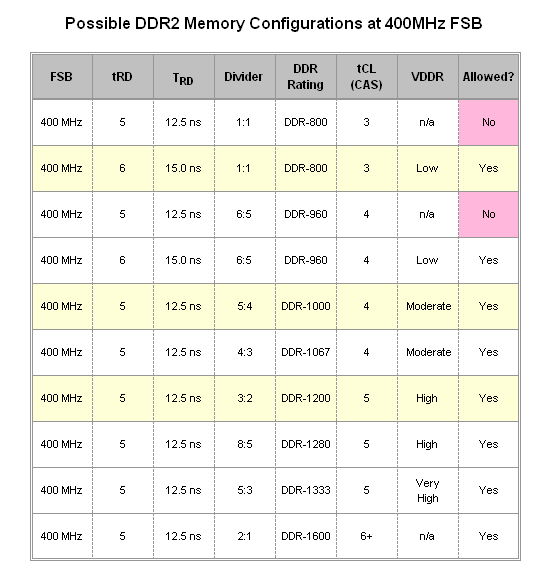
For the 400MHz FSB case three configurations stand out in particular - 1:1 for DDR2-800, CAS 3; 5:4 for DDR2-1000, CAS 4; and 3:2 for DDR2-1200, CAS 5. Of these three the last two are actually more appealing, not only because they offer the potential for higher memory bandwidths but also because a tRD of 5 is allowed for these configurations whereas CAS 3 operations using a 1:1 divider at 400MHz FSB is not possible with a tRD of 5. These results can be predicted using the "POST Test Equation" provided on the previous page. Those that choose to operate at 400MHz FSB (assuming this bus speed can be appropriately matched with one of their processor's available multipliers) need to decide whether to run the 5:4 or 3:2 divider. The decision might come down to the amount of memory being used - DDR2-1200 can be a rather lofty goal with four DIMMs installed, in which case DDR2-1000 would be the next best choice.
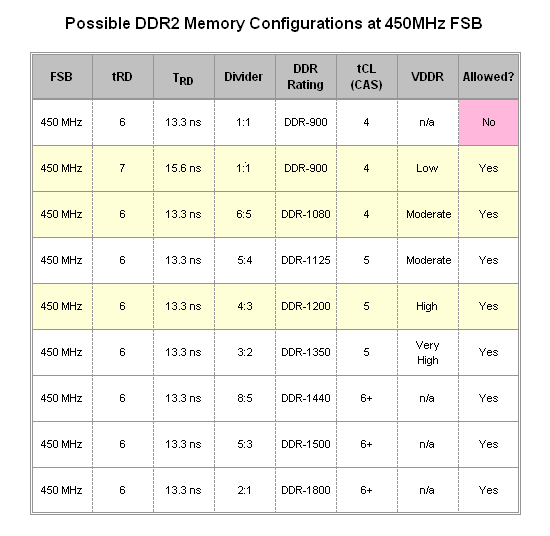
Moving on to the analysis at 450Mhz FSB, although we are able to show impressive memory read speeds at this same bus frequency using a 3:2 divider for DDR2-1350 CAS 5 at a tRD of 5, this configuration was far from stable on stock cooling alone - as was the memory speed. Most likely, the need to loosen tRD to 6 will be inevitable at this bus speed. Right from the start, we can see that TRD takes a hit as our minimum values thus far came at the lower 400Mhz FSB. What's more, possible memory configurations at this FSB do not seem to offer any real improvement over those at 400MHz. The first option worth considering, DDR2-900 at CAS 4, can be a little slow, especially considering that a tRD of 6 is not allowed. The DDR2-1200 choice will provide (at best) only miniscule gains over the same memory speed at 400MHz FSB because of the additional throughput efficiency made possible by the higher bus speed. Then again, the increase in TRD to 13.3ns, up from the minimum value of 12.5ns at 400MHz FSB, may completely negate any chance of a performance gain. Our last contender, DDR2-1080 at CAS 4, might be another neutral choice - on one hand there could be a small gain in performance over DDR2-1000 (CAS 4) seen at 400MHz FSB, but again the higher TRD may be this configuration's undoing.
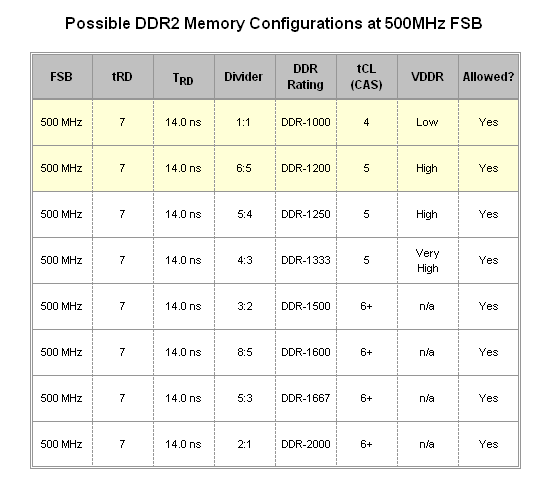
The meaningful choices at 500MHz FSB are even bleaker - here we find only two that merit any kind of attention (although you might be able to argue a point for the DDR2-1250 configuration). Having to further loosen tRD to 7 only compounds the issue of the slipping TRD value that we first saw at 450MHz FSB. On top of this, the DDR2-1000 CAS 4 and DDR2-1200 CAS 5 memory speeds are not unique to this FSB, effectively removing any incentive in choosing this bus frequency. Furthermore, the 4:3 and greater dividers are practically worthless as they attempt to push DDR2 memory to mostly unattainable speeds. Considering this, there is only one reason we would ever recommend bus speeds this high and that would be in the case of a severely limited CPU multiplier in which the extra FSB is required by the processor alone.
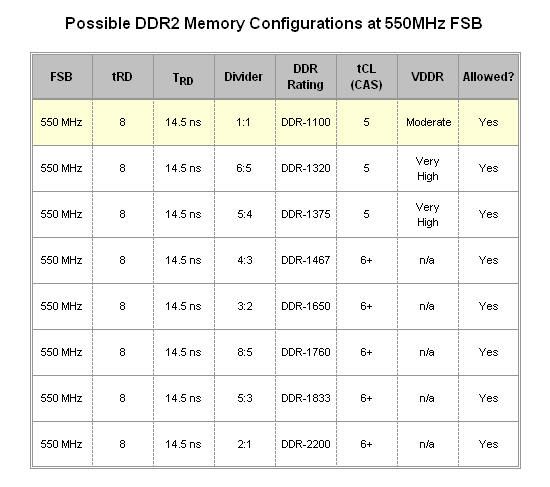
Without a doubt, 550MHz FSB represents the coup de grâce of ridiculously high bus speeds with only one divider (1:1) providing any substance to this horrible choice in settings. Again, we see the uncontrollable relaxation of TRD (at 14.5ns), which when coupled with a memory configuration of DDR2-1100 at CAS 5 certainly does not create a situation worth writing home about. Why anyone would choose to run their system this way is beyond us.
If there is one thing our studies here should teach us, it's the futility of searching for maximum performance in outrageously high bus speeds. Truthfully, we would argue that the best selections are possible at the "low" FSB of 400Mhz. Let us make it perfectly clear by saying that none of us here at AnandTech would ever tell you that 400Mhz FSB is an inferior choice. In fact, many of us make heavy use of this exact bus speed when setting up our personal systems for daily use. In the interest of fairness, let's take one last look at all of the highlighted configurations from the tables above.
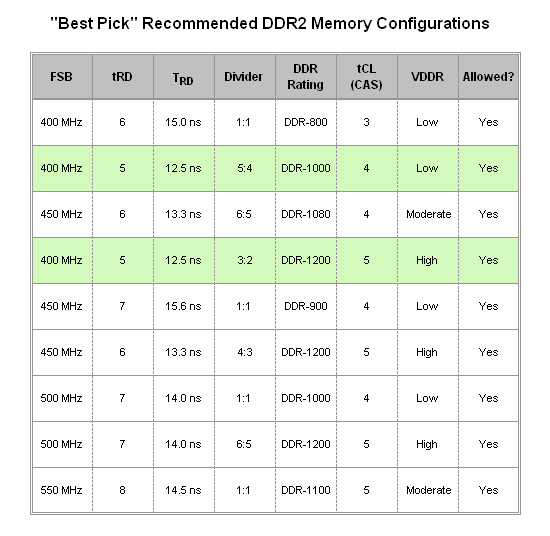
When viewed together the task of picking out a couple of the best choices becomes rather simple. A+ ratings, of course, go to the two configurations colored in light green (5:4 for DDR2-1000 CAS4 and 3:2 for DDR2-1200 CAS 5). You may be surprised, as we mentioned earlier, that they both use a humble 400MHz bus speed. If forced to choose another option, close second place awards might go to 450Mhz FSB - 1:1 and DDR2-900 CAS 4, or 4:3 DDR2-1200 CAS 5 (assuming your motherboard is capable of stable operation with the sometimes poorly implemented 4:3 divider). Just do not forget - whatever memory option you choose, be sure to remember the importance of tRD.
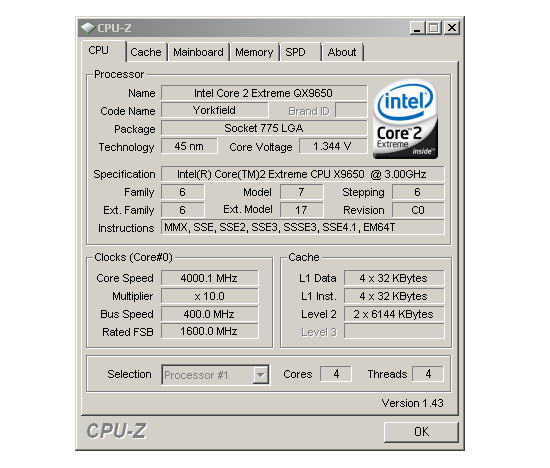
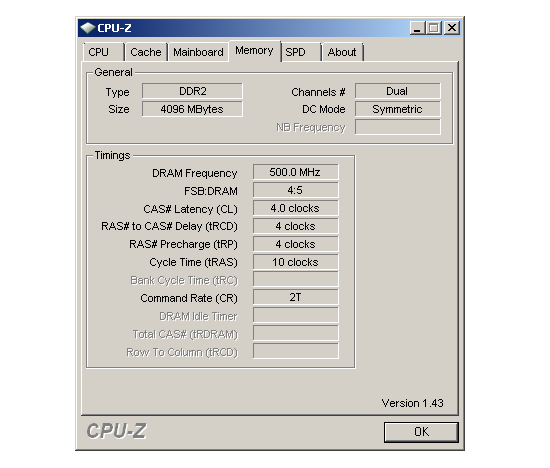
In the end we decided to run our Intel Core 2 Extreme QX9650 at a final FSB of 400MHz with a multiplier of 10.0x at an even 4GHz. Our 4x1GB of OCZ DDR2 PC2-8000 Platinum Extreme Edition memory was set to run at DDR2-1000 (5:4) CAS 4 with a tRD of 5. Ultimately, the ASUS Rampage Formula provided us the ability to build a well-tuned system. Without question, ASUS' addition of BIOS options for direct tRD manipulation was instrumental to our successful overclock. When paired with top-end GPUs from either ATI or NVIDIA, our rig becomes a formidable gaming platform for enjoying today's titles and beyond.










73 Comments
View All Comments
Bozo Galora - Friday, January 25, 2008 - link
Yet another world class article by Mr. BoughtonNot only do you give the insight, but you make it easily UNDERSTANDABLE.
You da man
AndyKH - Friday, January 25, 2008 - link
Also... is this tRD adjustment only possible with a X48 board? If not, I would have preferred that this article was kept seperate from an article about a specific motherboard. Don't get me wrong, I think it is a very informative article :-).If it is possible to adjust the tRD on other chipsets than the X48, can the possibility of setting the tRD as low as 5 then be attributed to the X48?
Gary Key - Friday, January 25, 2008 - link
tRD functionality within the BIOS is dependent upon the motherboard manufacturer. We have been harping on the motherboard suppliers to fully open up the BIOS on the enthusiast boards, this includes tRD and associated phase changes. ASUS is one of the first (DFI also) to offer an extensive range of settings in this particular area (most BIOS releases handle tRD adjustments automatically). We debated on separating the article content but due to the BIOS options available, they were more or less tied to each other. Yes, if tRD is available in the BIOS, it can be set on other Intel based boards or chipsets. In fact, I had very good success on the ASUS 780i board with tRD adjustments. Thanks for the comments! :)Georgeisdead - Wednesday, February 27, 2008 - link
Would tRD be called something else? Perhaps Read to Write Delay (tRWD)? I have an EVGA 680i board and I cannot find the tRD setting. I don't even see it as an available option with memset 3.4. Does anyone know of a synonym for tRD?Brunnis - Friday, January 25, 2008 - link
The Gigabyte GA-P35-DS3 has a BIOS option to set tRD and I seem to remember that it had a large effect on memory performance. Would this be the setting that you talk about here. If it is, it seems ASUS isn't the first one to offer it.Shoal07 - Friday, January 25, 2008 - link
Can anyone confirm you can set the tRD to anything besides innoculous settings like "auto" "high" and "low" on the GA-P35-DS3, and specify if its the L or R? Also, what memory was used in this test? (I read the whole article and I don't recall the specs of the system/testbed as a whole).Brunnis - Friday, January 25, 2008 - link
I have checked my GA-P35-DS3 again. The option is labeled "Static tRead Value" in the BIOS and can be set to any integer value between 1 and 31. Modifying this value changes the "Performance Level" as reported by the Windows program MemSet 3.4 accordingly. Changing the value from 8 to 7 on my board yielded the following results in Sisoft Sandra bandwidth benchmark:tRD 7: 7117 / 7139 (MB/s)
trD 8: 7026 / 7045 (MB/s)
Pretty large different from changing a single timing one step.
AndyKH - Friday, January 25, 2008 - link
Is it correctly understood that no other motherboards allow the tRD to be adjusted from within the BIOS, or is it simply because this board has named the setting something sensible? I think the article is a bit unclear about that.legoman666 - Friday, January 25, 2008 - link
Very enlightening article. The only thing missing are real world application tests showing the benefits in office applications, games (most important ;) ), and encoding.Gary Key - Friday, January 25, 2008 - link
We will have full application benchmarks in the X48 roundup that Kris and Raja are working on.